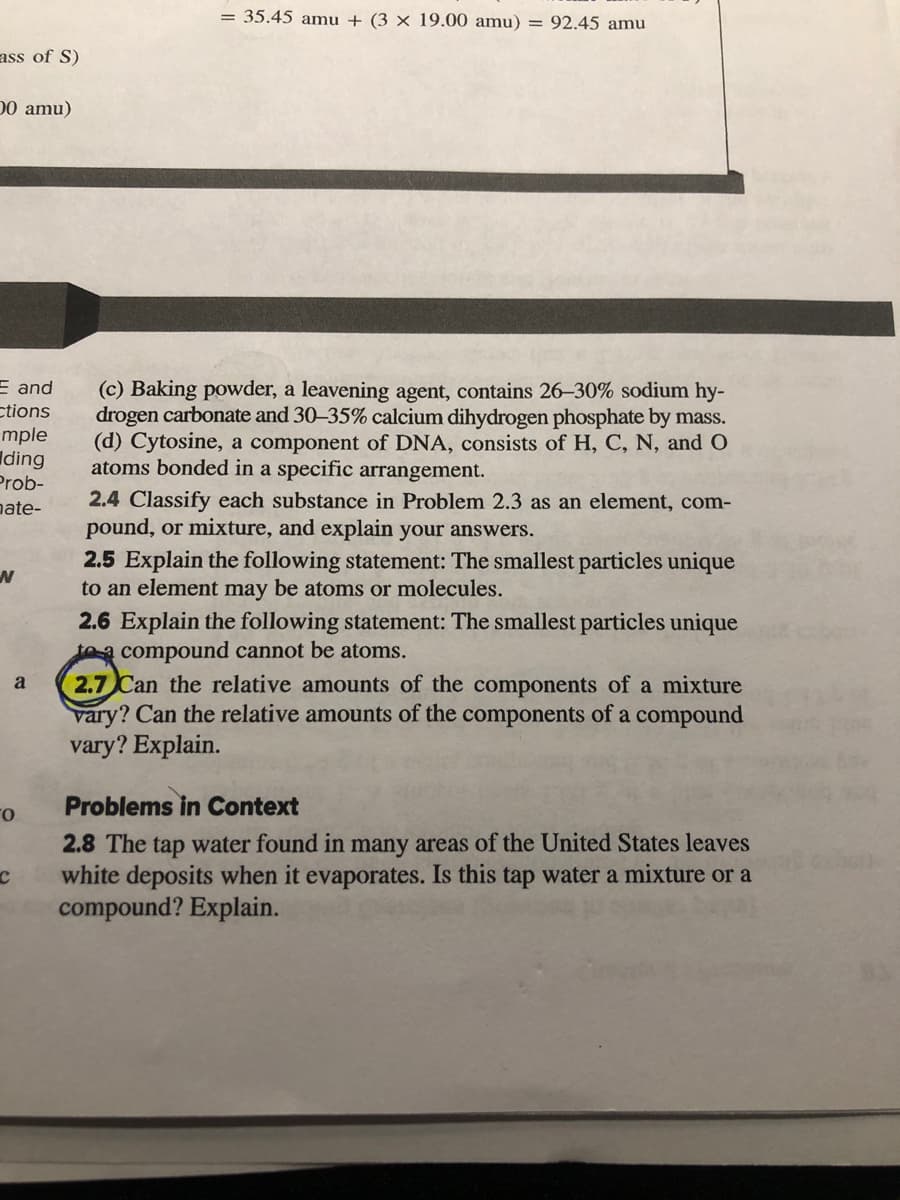t0a compound cannot be atoms. 2.7 Can the relative amounts of the components of a mixture vary? Can the relative amounts of the components of a compound vary? Explain. a Problems in Context 2.8 The tap water found in many areas of the United States leaves white deposits when it evaporates. Is this tap water a mixture or a compound? Explain.
t0a compound cannot be atoms. 2.7 Can the relative amounts of the components of a mixture vary? Can the relative amounts of the components of a compound vary? Explain. a Problems in Context 2.8 The tap water found in many areas of the United States leaves white deposits when it evaporates. Is this tap water a mixture or a compound? Explain.
Chemistry: Principles and Practice
3rd Edition
ISBN:9780534420123
Author:Daniel L. Reger, Scott R. Goode, David W. Ball, Edward Mercer
Publisher:Daniel L. Reger, Scott R. Goode, David W. Ball, Edward Mercer
Chapter5: Thermochemistry
Section: Chapter Questions
Problem 5.101QE: In the 1880s, Frederick Trouton noted that the enthalpy of vaporization of 1 mol pure liquid is...
Related questions
Question
Only question highlighting

Transcribed Image Text:= 35.45 amu + (3 × 19.00 amu) = 92.45 amu
ass of S)
D0 amu)
E and
(c) Baking powder, a leavening agent, contains 26-30% sodium hy-
drogen carbonate and 30-35% calcium dihydrogen phosphate by mass.
(d) Cytosine, a component of DNA, consists of H, C, N, and O
atoms bonded in a specific arrangement.
ctions
mple
Iding
Prob-
nate-
2.4 Classify each substance in Problem 2.3 as an element, com-
pound, or mixture, and explain your answers.
2.5 Explain the following statement: The smallest particles unique
to an element may be atoms or molecules.
2.6 Explain the following statement: The smallest particles unique
toa compound cannot be atoms.
2.7 Can the relative amounts of the components of a mixture
vary? Can the relative amounts of the components of a compound
vary? Explain.
a
Problems in Context
2.8 The tap water found in many areas of the United States leaves
white deposits when it evaporates. Is this tap water a mixture or a
compound? Explain.
Expert Solution
This question has been solved!
Explore an expertly crafted, step-by-step solution for a thorough understanding of key concepts.
This is a popular solution!
Trending now
This is a popular solution!
Step by step
Solved in 3 steps with 2 images

Knowledge Booster
Learn more about
Need a deep-dive on the concept behind this application? Look no further. Learn more about this topic, chemistry and related others by exploring similar questions and additional content below.Recommended textbooks for you

Chemistry: Principles and Practice
Chemistry
ISBN:
9780534420123
Author:
Daniel L. Reger, Scott R. Goode, David W. Ball, Edward Mercer
Publisher:
Cengage Learning

Introduction to General, Organic and Biochemistry
Chemistry
ISBN:
9781285869759
Author:
Frederick A. Bettelheim, William H. Brown, Mary K. Campbell, Shawn O. Farrell, Omar Torres
Publisher:
Cengage Learning

Physical Chemistry
Chemistry
ISBN:
9781133958437
Author:
Ball, David W. (david Warren), BAER, Tomas
Publisher:
Wadsworth Cengage Learning,

Chemistry: Principles and Practice
Chemistry
ISBN:
9780534420123
Author:
Daniel L. Reger, Scott R. Goode, David W. Ball, Edward Mercer
Publisher:
Cengage Learning

Introduction to General, Organic and Biochemistry
Chemistry
ISBN:
9781285869759
Author:
Frederick A. Bettelheim, William H. Brown, Mary K. Campbell, Shawn O. Farrell, Omar Torres
Publisher:
Cengage Learning

Physical Chemistry
Chemistry
ISBN:
9781133958437
Author:
Ball, David W. (david Warren), BAER, Tomas
Publisher:
Wadsworth Cengage Learning,